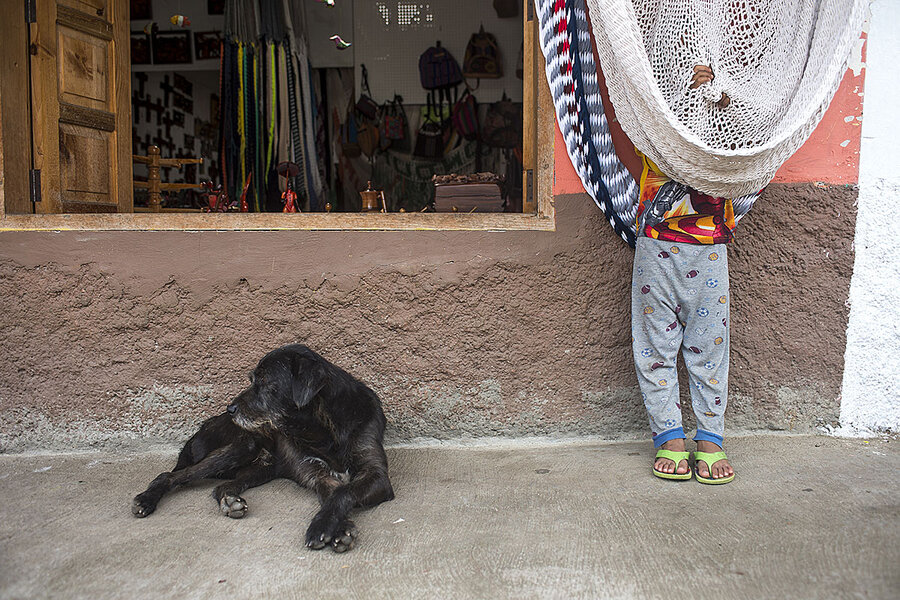Hammocks in Honduras: from inside prison walls to city streets
Loading...
| San Pedro Sula and Tamara, Honduras
Honduras, a Central American nation of 9 million people, has one of the world’s highest homicide rates. Its prisons are known for violence, overcrowding, and historically lax oversight. But they’re also the birthplace of something you might not expect: the majority of the country’s ubiquitous hammocks. On a recent morning at Tamara National Penitentiary, the largest in Honduras, Adrian Vasquez circles a makeshift loom, weaving sky-blue thread into a creation of alternating horizontal and vertical stripes. Around the property, other men lay out damp laundry, run laps on a dirt track, and rehearse Christian rock songs in an open-air church. Prisoners are encouraged to take classes and learn job skills, but the hammock businesses are prisoner-run, with visiting relatives dropping off supplies and picking up finished products to sell or distribute throughout the country. A simple hammock earns a prisoner here about $3, but resale prices range from $10 to $60 across the country.
Why We Wrote This
When a Monitor reporter and photographer traveled to Honduras, they noticed hammocks everywhere. But instead of beach-front vistas, their reporting took them to the heart of the country's largest prison – and led to this unexpected photo gallery.
Hammocks are ubiquitous in this mountainous, Central American nation. From quaint crafts markets to bustling metropolitan intersections, the colorful textiles are snapped up by locals and tourists alike. But their origins are more complex than the images of relaxation and siestas that they evoke.
The majority of hammocks in Honduras are informally produced in its roughly 30 prisons, better known for their violence, overcrowding, and historically lax oversight. Honduras has one of the highest homicide rates in the world. In 2016, 59 per 100,000 people were killed, and 96 percent of homicide cases end in impunity.
Just outside the capital, the Tamara National Penitentiary is home to some 5,200 prisoners, the largest in the country. On a recent morning, men lay out damp laundry on the paved road that cuts through the middle of the prison, as if it were a small city. Others keep busy sanding wooden furniture, running laps on a dirt track, or rehearsing Christian rock songs in an open-air church.
Why We Wrote This
When a Monitor reporter and photographer traveled to Honduras, they noticed hammocks everywhere. But instead of beach-front vistas, their reporting took them to the heart of the country's largest prison – and led to this unexpected photo gallery.
[Click the photograph for a gallery of Ann Hermes's images from Honduras. The story continues below.]
Tucked along an orange brick wall, Adrian Vasquez circles a makeshift loom, set up with two wooden poles in the ground. He’s weaving sky-blue thread into a creation of alternating horizontal and vertical stripes. Around the corner, a man pumps a black, hand-turned wheel, filling the alleyway with a rhythmic click-clacking sound. Others feed thin white threads into the contraption, helping spool them into string.
Mr. Vasquez has been in prison for about three months – though he hasn’t been tried or sentenced, yet, he says. He learned how to make his first hammock here, and now produces about three per week. “It passes the time,” he says. Prisoners are encouraged to take classes and learn job skills, but the hammock businesses are entirely prisoner-run, says German Mcniel Rueda, the deputy director of the National Penitentiary Institute. Family members often bring in materials and pick up completed projects to sell around the country. More than 60 percent of Hondurans live below the poverty line. When relatives can’t afford supplies, prisoners will sometimes work with recycled goods, like old t-shirts or plastic bags. A simple hammock earns a prisoner here about $3 dollars, but resale prices range from $10 to $60 across the country.
Julia Guerrero and her daughter hawk hammocks on a sweltering corner in San Pedro Sula. On the opposite side of the street sits a now-shuttered prison, once nicknamed the “University of Crime” for gang activity that overran any semblance of control within its walls. “Business has been tough since the prison closed” last year, says Ms. Guerrero, who has always sourced most of her inventory from Tamara, where a neighbor’s husband is incarcerated. “We used to have people coming from around the world to visit their [jailed] loved ones and they’d buy a hammock from me on their way out.”
Although few customers ask Guerrero about the people behind her hammocks, she says she’s happy her business can give incarcerated Hondurans a purpose. “Whether you’re in jail or not, employment is sacred” here, she says.









